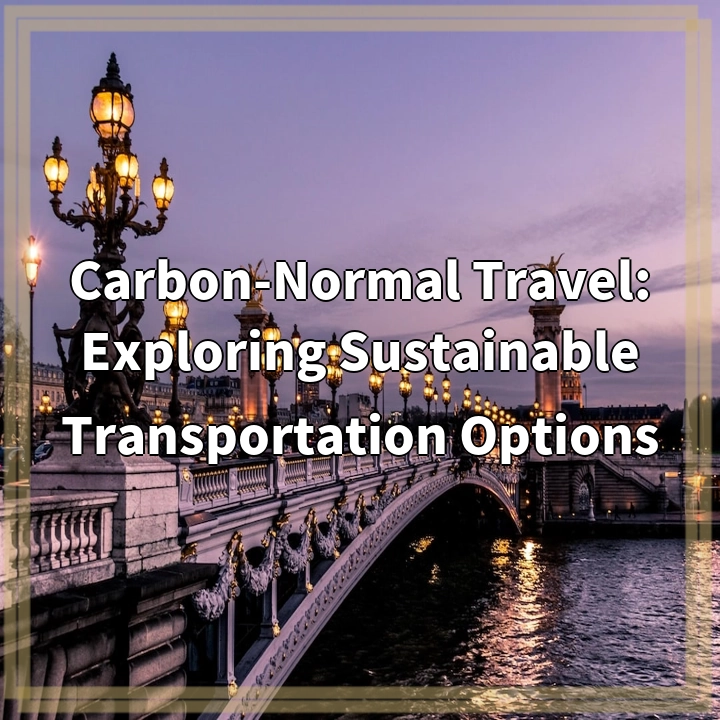
What is Carbon-Normal Travel?
Carbon-normal travel refers to the concept of minimizing or offsetting the carbon emissions associated with various modes of transportation. It involves adopting sustainable transportation options that have a minimal impact on the environment, or finding ways to compensate for the emissions produced during travel. The aim is to achieve a net-zero carbon footprint, where any greenhouse gas emissions are balanced out by activities that reduce or remove an equivalent amount of emissions.
Real-World Problems Associated with Carbon-Normal Travel
1. High Carbon Footprint of Conventional Transportation
One of the significant challenges of carbon-normal travel is addressing the high carbon footprint associated with conventional transportation methods. Transport, particularly aviation and personal vehicle use, contributes a considerable share of global carbon emissions. This poses a significant obstacle in achieving sustainability goals and requires alternative transportation options to be explored.
2. Limited Infrastructure for Sustainable Transportation
Another challenge is the limited infrastructure available for sustainable transportation options. Public transportation networks, cycling lanes, and pedestrian-friendly infrastructure are often inadequate or lacking in many regions. This lack of infrastructure makes it difficult for individuals to choose eco-friendly alternatives, hindering efforts to reduce carbon emissions in the transportation sector.
3. Affordability and Accessibility of Sustainable Options
Sustainable transportation options such as electric vehicles or high-speed rail systems may come with a higher upfront cost or limited accessibility for certain communities. The affordability and accessibility of these alternatives can pose challenges, particularly in lower-income areas or remote regions where sustainable transportation infrastructure may not be readily available.
4. Lack of Consumer Awareness and Education
Many travelers are unaware of the carbon emissions associated with their transportation choices or are less informed about the potential sustainable alternatives. A lack of consumer awareness and education on carbon-neutral travel options hinders the adoption of more sustainable transportation practices. Efforts are needed to increase awareness and provide educational resources to empower individuals to make informed choices.
5. Difficulty in Measuring and Monitoring Carbon Footprints
accurately measuring and monitoring individual carbon footprints from travel can be challenging. Determining the emissions associated with different modes of transportation, taking into account factors such as distance traveled, fuel efficiency, and occupancy rates, requires data and calculations that may be complex and not easily accessible to the average traveler. This can make it challenging to determine the effectiveness of carbon-normal travel initiatives or identify areas for improvement.

Solutions for Carbon-Normal Travel
Overcoming the challenges associated with carbon-normal travel requires a combination of individual and collective actions, along with policy and infrastructure changes. Here are some potential solutions to consider:
1. Investment in Sustainable Transportation Infrastructure
Governments and local authorities should prioritize investment in sustainable transportation infrastructure. This includes expanding and improving public transportation networks, creating dedicated cycling and pedestrian paths, and promoting electric vehicle charging stations. By enhancing the availability and accessibility of sustainable transportation options, individuals are more likely to choose these alternatives over conventional modes of travel.
2. Encouraging Modal Shifts
Promoting modal shifts, such as encouraging travelers to prioritize trains over planes for shorter distances or opting for carpooling or ride-sharing services, can significantly reduce carbon emissions. Education campaigns and incentives can help raise awareness and inspire individuals to choose more sustainable transportation options.
3. Carbon Offset Programs
Carbon offset programs provide a way to compensate for the emissions produced during travel by investing in projects that reduce or remove carbon from the atmosphere. These projects can include reforestation efforts, renewable energy initiatives, or methane capture projects. Supporting and participating in certified carbon offset programs can help individuals and businesses offset their carbon footprint and contribute to a more sustainable travel industry.
4. Integration of Technology
Technological advancements can play a significant role in reducing carbon emissions from transportation. The development and widespread adoption of electric vehicles, improved fuel efficiency in airplanes, and the use of smart transportation systems can contribute to a more sustainable travel industry. Embracing emerging technologies and innovating transportation solutions can help mitigate the environmental impact of travel.
5. Collaboration and Advocacy
Collaboration between stakeholders, including governments, businesses, and individuals, is essential in driving sustainable transportation practices. Advocacy for policies that prioritize sustainable transportation, lobbying for increased funding for infrastructure development, and supporting initiatives aimed at raising awareness about carbon-normal travel are critical for creating lasting change.















